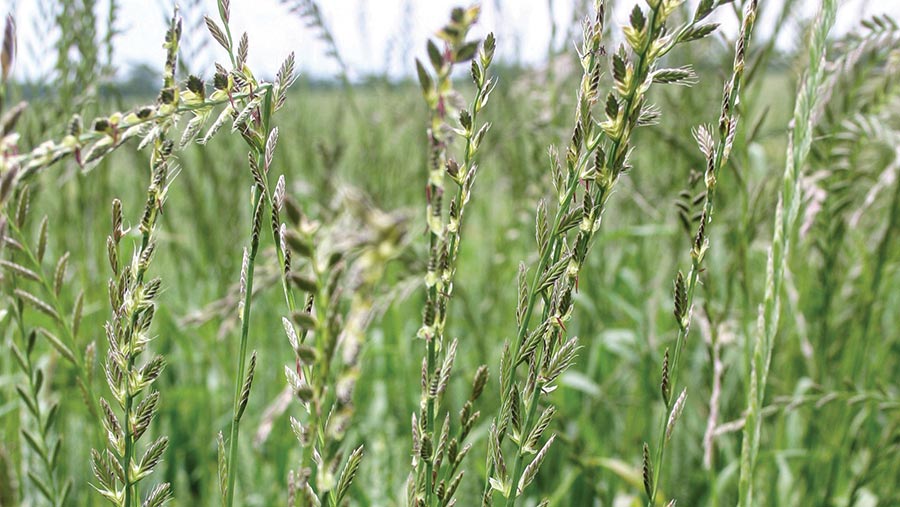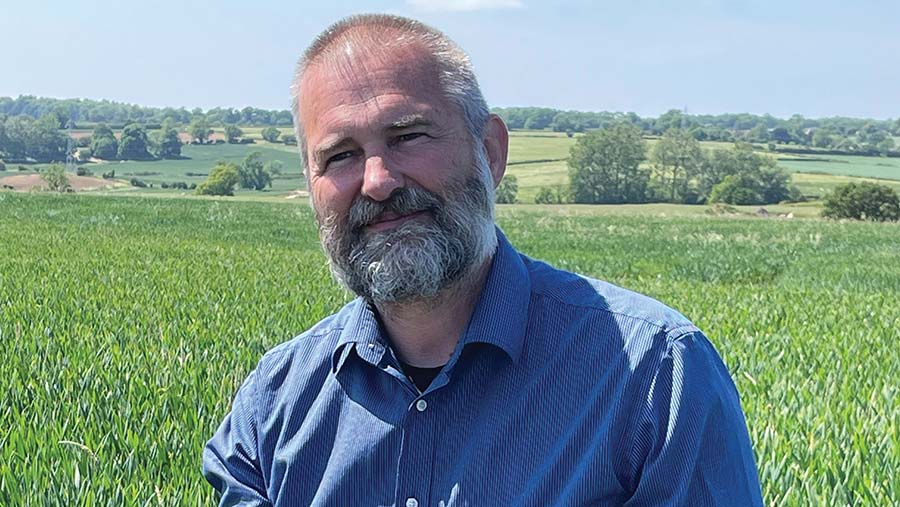4 reasons Italian ryegrass is a growing threat to arable growers
 © Blackthorn Arable Ltd
© Blackthorn Arable Ltd While blackgrass remains by far the most common grassweed issue on arable farms across the country, Italian ryegrass is increasingly seen as the most challenging to control.
A survey in 2021 conducted by Niab on behalf of Bayer, for example, suggested nearly 90% of those who sent in Italian ryegrass samples were seeing either a slight or a big increase in levels on farm.
And while that was undoubtedly a self-selecting sample of farmers, it mirrored other surveys by Monsanto, Bayer and Gowan that have picked up an increasing problem with the weed.
See also: How arable farmers can turn things around this spring
Research is now starting to gain a better understanding of the biology of Italian ryegrass, and it’s not exactly good news for its control, as the findings suggest traits that make control strategies used to reasonably effectively control other grassweeds, and especially blackgrass, will be less successful for Italian ryegrass.
At the recent annual BCPC Weed Control review, John Cussans, weed biology and management specialist for Niab, highlighted some of the challenges growers faced.

John Cussans © MAG/David Jones
Protracted emergence
While most emergence is typically in the autumn, with the vast majority in October, there is a relatively long tail of emergence into the spring, John says.
“In our annual monitoring of fixed quadrats in herbicide trials since 2017, it’s also variable. There are seasons where in the assessment around Christmas there are twice as many individuals as just after drilling.
“But our worry about late-emerging Italian ryegrass plants is that the threat they pose is much more impactful than in blackgrass.”
An example on a farm in Kent showed that despite the number of ryegrass seedlings reducing with later drilling dates, the number of heads actually went up from the later drilling dates.
The lack of competitiveness from a spring-drilled crop in that year ended up meaning a lower population of plants actually produced more seed, John notes.
“That’s a challenge, as one of our go-to cultural controls for blackgrass has been to put in a spring crop, or sequence of spring crops. If you try to do that with Italian ryegrass, it can be effective in a single season but over time you’re likely to come unstuck at some point.
“I’m not saying it’s not part of the overall strategy, but definitely those later germinating weeds are a threat.”
Niab has also carried out trials comparing cultivations – ploughing, non-inversion deep tillage, and true direct drilling across three drilling dates, which showed reductions in ryegrass heads from delayed drilling and for deeper tillage, with ploughing being best.
“It’s like blackgrass,” John says. “But everything is just a little bit less effective, and that also just feeds through with work with things like the effectiveness of crops competition.
“I think people employing a blackgrass blueprint against Italian ryegrass need to think about the threat differently and where the risk is coming from.”
Genetic diversity
Analysis of the 196 samples collected as part of the Bayer/Niab survey has revealed much more genetic diversity in Italian ryegrass weed populations than in blackgrass.
For example, some seeds don’t have awns whereas traditionally ryegrass seeds would be awned. “These must be coming from a different genetic background,” John says.
There is also genetic diversity in the length of vernalisation required to trigger flowering.
Plants with a high vernalisation requirement – meaning the seeds need a longer period of cooler weather – are optimised to produce more seed in an early autumn-drilled crop, whereas plants with a low vernalisation requirement will produce more seed in spring crops.
“The genetic diversity in this trait means we have weeds that are essentially adapted for different rotations. That’s going to be a real challenge for how we manage it.”
Similarly there is also variation in the dormancy of freshly shed seed and whether dark suppresses germination.
“It’s all hinting that part of the problem with this weed is we have such a high amount of genetic diversity that we don’t really understand yet.”
Herbicide sensitivity
That genetic variation also makes it more difficult to plan effective use of herbicides against Italian ryegrass.
For example, analysis of control levels from the same herbicide on different fields on the same farm has shown that there are significant differences in herbicide sensitivity between individual fields.
“What this means is that on your farm, the resistance status of a ryegrass population in one field is actually a worse predictor of the resistance status in a second field than just guessing,” John says.
That does not mean resistance testing has no value, he stresses, but it does need to be carried out on a field-by-field basis rather than using the results of one test from one field to determine the resistance status of Italian ryegrass across the whole farm.
Analysis of the samples collected in the Bayer/Niab survey also showed huge variation in sensitivity to three wheat herbicides – Atlantis (iodosulfuron + mesosulfuron), Axial (florasulam + pinoxaden) and flufenacet.
Roughly half showed some resistance to Atlantis and Axial, John says. “But it’s not the same half, which is important. There are complex cross-resistance patterns.”
But most worryingly, in nearly 10% of samples flufenacet provided no control. “That’s kind of happened under our noses.”
This highlights the increased threat from Italian ryegrass compared with blackgrass, where, while there is evidence of a shift in sensitivity against flufenacet, there is still good control at the highest rate.
In comparison, flufenacet showed no control of an Italian ryegrass population collected in Kent at even five times the legal maximum rate, John says.
“This is a new horizon for us to see absolute insensitivity in a pre-emergence residual herbicide rather than a contact herbicide. It’s something we need to get used to and be aware of how quickly it is evolving.”
New actives, such as cinmethylin and the yet-to-be-approved bixlozone, are both excellent against Italian ryegrass, which provides optimism for the short term at least, but there must be a focus on using a diverse range of actives in control programmes, John stresses.
“Focus on sequencing and splitting actives across the whole germination window,” he says.
“That partly hedges around application conditions, partly to legislate for emerging weeds, but crucially to promote a mode of action diversity strategy.
“We have six modes of action to combat this weed and we need to use them all sensibly to not rely on any particular mode of action, because we know that will drive insensitivity over time.”
Glyphosate concern
Perhaps the greatest risk from Italian ryegrass is the apparent potential to select for insensitivity to glyphosate, John warns.
Globally there are multiple instances of resistance developing to glyphosate in various ryegrass species.
That includes Italian ryegrass species, most often in perennial cropping, but increasingly in annual cropping, often driven by genetically modified herbicide-tolerant cropping.
“But we’re also beginning to see cases in Europe in arable rotations,” John says.
In the UK, Niab tested 50 samples of “difficult” Italian ryegrass with different glyphosate doses and found nearly a five times difference in glyphosate sensitivity from the least to most sensitive populations.
That compared with less than two times difference in sensitivity in blackgrass populations tested by Laura Davies as part of a PhD project while at Warwick University.
The team at Niab has also been able to demonstrate the potential to select for glyphosate insensitivity in the field from a UK-sourced population.
The plants were dug up in a field having survived multiple doses of glyphosate in a no-till system ahead of late spring drilling, John explains.
“The farmer carried out some aggressive cultivation because you could see there was potentially an issue and we’ve retested the same field without finding any problems.
“But we dug up some of these survivors and grew them on in a pollen-isolation chamber, and showed they were resistant to glyphosate.”
He says it is not yet in a field population, but it is a stark warning of where the risk is for this weed.
“Monitoring glyphosate sensitivity is now an absolute priority in this species both nationally and on individual farms,” he says.
How did the weed form of Italian ryegrass originate?
There is uncertainty about where weed populations of Italian ryegrass came from.
An important forage plant, Lolium multiflorum, is indistinguishable visually from the arable weed version, but there are important differences, John Cussans explains.
For example, the crop plant has very little persistency in the seedbank, the seed doesn’t have any dormancy and plants all flower at the same time, he says.
“The weed plant is very definitely different – an ecotype – and not just escaped Italian ryegrass forage populations.
“But what we don’t know is what the process is that gives rise to this ecotype.”
Broadly, there are two different possibilities, he suggests.
- Selection happened once in the forage crop to give rise to the arable weed version, which is now spreading as any other arable weed does on machinery and through farm management, and the two types are effectively entirely separate.
- Or selection happens virtually every time you grow Italian ryegrass as a forage crop.
“The truth is likely to be somewhere in between the two,” John says.
“It’s probably not happened just once, but it’s also really unlikely that every time you grow the forage version it escapes because if that was true there would be a strong association between forage use and arable weed occurrence, which there isn’t.
“But it is important to understand where the balance is between those two extremes, because as an industry we don’t know where to focus – whether it should be on biosecurity around the use of Italian ryegrass as a forage crop, or biosecurity to prevent the arable weed spreading.”
John Cussans was speaking at a recent British Crop Production Council Weed Control Review held at Niab, Cambridge.

